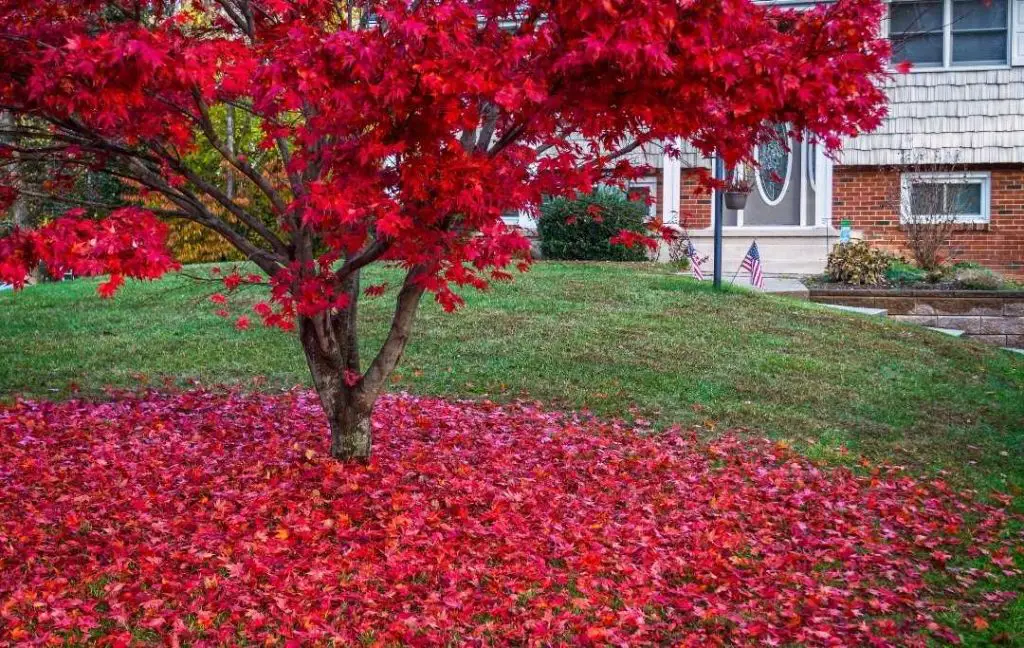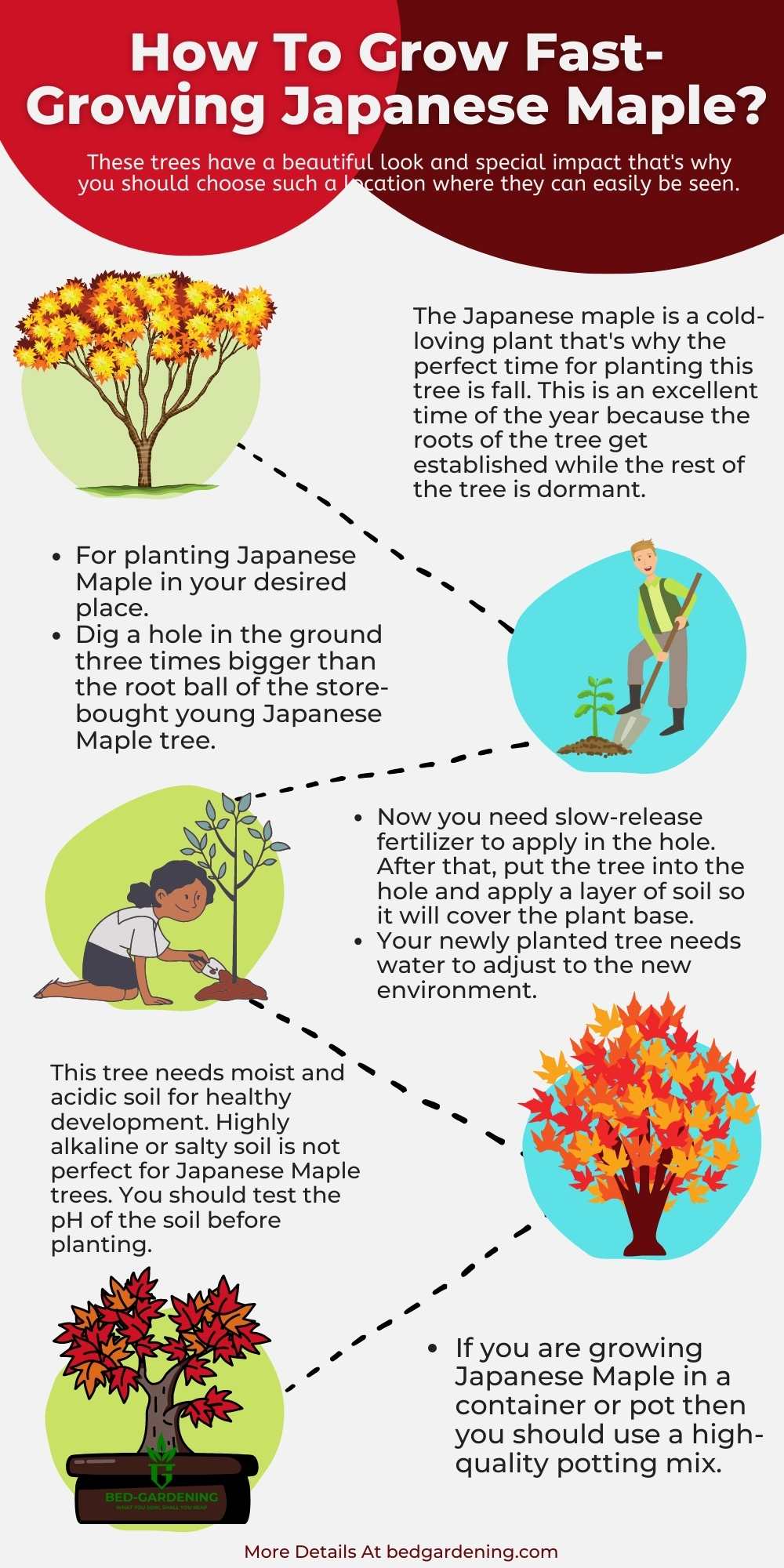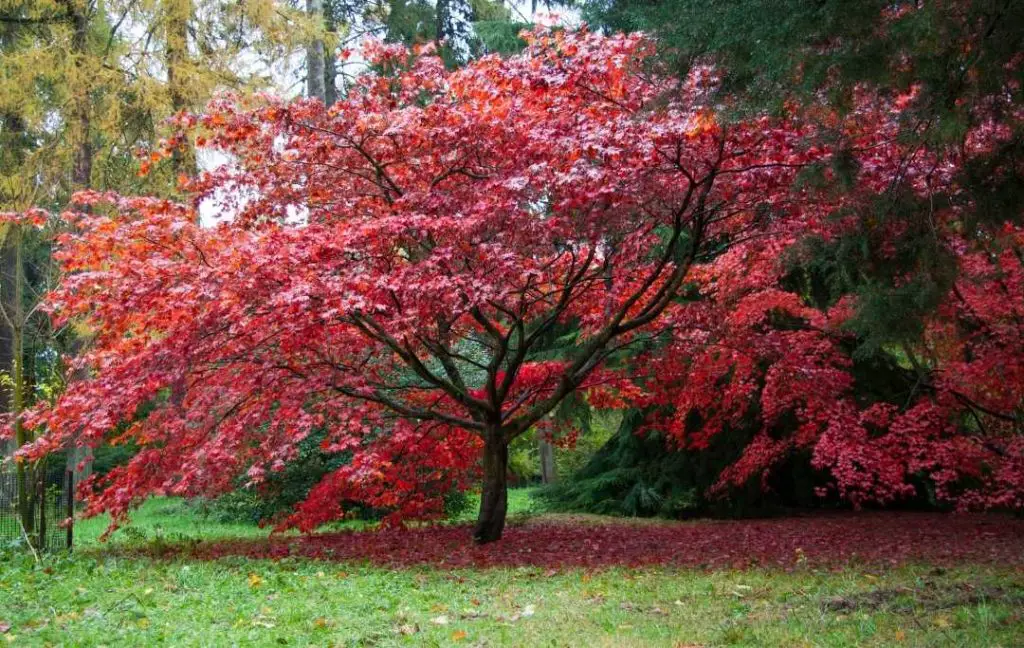Japanese maple is a fast-growing, compact, disease-resistant, low-maintenance, and cold hardy tree. The colors of stunning foliage of Japanese maple dazzle in spring and summer.
The shape of the leaves is pointed and just like a stretched hand. The translucent sheen of leaves makes them shine in the sun. Japanese maple prefers a cold climate because of its exceptional cold hardiness.

Sun-scorch is a big problem for Japanese maples in hot regions. In that case, you should choose a shady place and provide them with sufficient water.
Japanese Maple’s Growth Rate
In every season Japanese maple grows about 12 inches. The height of a 15 years old tree can be 10 to 15 feet. A mature tree can be grown up to 10 to 20 ft.
Much of the Japanese maple’s growth comes during its earlier years. If you want your Japanese Maples to grow very fast, you should provide suitable conditions for them.
For this purpose, you must plant these trees in an appropriate location where they get enough light to grow fast. Japanese Maple can tolerate partial shade and needs well-drained, moist soil. Your site must be protected from strong winds and harsh weather.
Japanese Maple In Gardens And Landscape
These trees have a beautiful look and special impact that’s why you should choose such a location where they can easily be seen. Most people think that Japanese maple is fit for oriental style; this is not true; they can fit in any garden style. Japanese maple can adjust to any landscape.
A courtyard garden, deck, or terrace can adjust any place. You can even grow it in planter boxes or large containers too. When you grow trees in a container then they become portable and you can move them to your desired location.
If you have a small garden and you want to grow a tree in it then you should be very selective because some trees grow very tall and as a result, you have to remove them. Japanese maple is an ideal small tree as it can grow 15 ft to 20 ft. You can control the height of the tree with pruning.
You can grow Japanese maple under mature and large trees in the large garden. They can easily adjust in shady areas, north facing or east-facing side is best beneath the evergreen trees is best for them.
Avoid planting them under trees that have dense shade. The shady location is perfect. You are living in a hot climate because the heat of the sun makes leaves dry and shrivel.
When To Plant?
Young Japanese Maple trees are very sensitive to heat and sunlight. The summer months are not perfect for planting this stunning tree. You should carefully consider your climate before planting Japanese Maple in your garden.
The Japanese maple is a cold-loving plant that’s why the perfect time for planting this tree is fall. This is an excellent time of the year because the roots of the tree get established while the rest of the tree is dormant.
You can also plant it in the spring but make sure there is no threat of frost. Because newly planted Japanese maples can’t tolerate frost.

How To Plant Japanese Maple?
- For planting Japanese Maple in your desired place.
- Dig a hole in the ground three times bigger than the root ball of the store-bought young Japanese Maple tree.
- Now you need slow-release fertilizer to apply in the hole. After that, put the tree into the hole and apply a layer of soil so it will cover the plant base.
- Your newly planted tree needs water to adjust to the new environment.
- This tree needs moist and acidic soil for healthy development. Highly alkaline or salty soil is not perfect for Japanese Maple trees. You should test the pH of the soil before planting.
- If you are growing Japanese Maple in a container or pot then you should use a high-quality potting mix.
You should be careful about the sunlight and water. You can apply a layer of mulch to maintain the moisture level in the soil.
Best Varieties Of Japanese Maple
Japanese Maple has a quality that it can adjust in any size of landscape or garden. This is a perfect small tree that adds interest to your growing area.
There are marvelous variations of Japanese Maple available.
Following are some options for the Japanese maple. You can choose one according to your choice.
1- CORAL BARK
You can see the beauty of Coral Bark on cold days because the color becomes more intense. In summer you can see bright green leaves that have red margins. These leaves turn yellow when fall comes. This variety of Japanese maple can grow up to 20 to 25 feet.
2- CRIMSON QUEEN
This tree is 8 to 12 feet wider and adds dimension to your garden. The color of the leaves changes according to the light they receive. In case, your tree is receiving partial sun then you will see lacy leaves have maroon color.
3- EMPEROR ONE
The height of this variety can be reached up to 15 feet. The color foliage turns from deep maroon to bright red in the fall season.
4- GREEN CASCADE
Green cascades can grow 20 feet to 25 feet wide. The foliage resembles ferns. When fall comes green leaves turn into bright red and yellow.
5- AUTUMN MOON
The foliage of the autumn moon is yellow and orange in Spring but it turns salmony-red in summer. You will be astonished to see the color of the foliage will be vibrant orange and red in the fall. The leaves of this variety are large just like palms.
6- RED DRAGON
The mature tree of the red dragon is about 6 to 8 feet wide and tall. You can see the stunning red color of foliage when fall comes. In summer it turns into dark burgundy. If you want to add color to your garden then you should buy a 2-year-old plant.
Keep Reading
- Grow Variegated Banana Plants Indoors
- 15 Dwarf Fruit Trees For Container Garden
- How To Grow Freesias In Pots?
Japanese Maple Care

Japanese maples create a striking focal point in any size of garden. You should be careful about many factors for growing a healthier Japanese maple.
1- LOCATION
First, you should choose such a site where your maple trees are protected from drying winds and afternoon sun. If you have heat resistant variety then you should not worry about this.
For a cascading form, the perfect place is a slope, the top of the wall, or the bank. These areas will show the beauty of the tree.
2- SOIL
After location, the second thing is soil because it will be a medium that provides essential nutrients to your plant to try well. Whatever the kind of soil you have in your garden, the important thing is that you should add a sufficient amount of organic matter before planting Japanese maples.
Compost, well-rotted animal manure, rotted leaves, or peat moss are organic materials that help to improve the richness of the soil. To improve the quality of the soil you can also add rock phosphate or bone meals as it will help in the growth of roots.
If you are facing the problem of limited space and decide to grow Japanese maple in a container then you can easily control the fertility of the soil.
Because when you grow plants in a container or pot you can easily maintain the richness of the soil which is not possible when you grow plants in the ground.
The container or pot you are using must be large enough with drainage holes. Japanese maples don’t like wet feet as they can kill your tree and become the reason for root rot and many fungal diseases.
If the container you are using doesn’t have drainage holes then you can make it with the help of a drill. Fill your container or pot with a high-quality potting mix that is easily available from any gardening store or nursery.
3- WATER
When you are planting Japanese maples then make sure they will get enough water. Never plant this tree in dry soil. It is suggested that you should apply a layer of mulch after planting the tree in the ground.
It will help to retain moisture in the soil. The newly planted Japanese maple needs regular water in the first year. In hot weather, they need more water so you have to increase the frequency of water.
In a hot climate, you should not reduce the amount of water during the winter season because of dry and sunny periods. The best way of watering your plant is that you should check the soil with the help of your finger. If it feels dry it means it is time to water your plants.
5- MULCH AND FERTILIZER
When spring comes apply a small quantity of fertilizer over the whole root zone. It is better to use liquid fertilizer for young trees. The maple trees that are planted in the containers or pots can be fed once a month during the growing period.
You should follow all the instructions and tips of the fertilizer. An excessive quantity of fertilizer can burn your plant. Dormant trees don’t need fertilizer.
6- PRUNING
The Japanese maple has a very beautiful and unique shape so there is no need for pruning. But if you want to give it an airy look then you can remove the lower limbs of the tree.
This will create a canopy. The best time for pruning is in the fall from July to August. Any shoots that are growing from the base should be removed because they will overtake the grafted section.
If the tree has small branches that may naturally die then you should at once remove them. To encourage the dense growth of the tree you can trim back the long shoots but avoid heavy trimming because it can destroy the natural beauty of the tree.
If you are growing Japanese Maple in a container or pot then it needs regular trimming to keep the size of the tree according to the space you have.
7- PESTS AND DISEASES
Pests are a threat that can destroy Japanese Maple. mite, Japanese beetles, scale, mealybug, and aphids are common pests that can attack this tree.
The easy way of getting rid of this problem is that you can dislodge all the pests with a strong stream of water. If the problem remains unsolved then another way of damaging your plant is to use pesticides. You should follow all the instructions and tips about the product you are using.
Like pests, diseases can also affect your plant. Verticillium wilt and canker are common diseases that can harm your Japanese maples. Regular watering and fertilizing make your tree healthy and prevent them from many diseases. Over or under watering is the main cause of many fungal diseases so you should be careful.
Anthracnose is another disease that can destroy Japanese Maple. Black spots on dying leaves are a clear symptom that your plant is affected by this disease.
There is no chemical cure for this disease so never keep the soil wet because a humid environment is a reason for anthracnose. To keep your garden clear from diseased and dead parts of the plants. Always use fresh and clean mulch.
